Development of an Ergonomic Writing Assistive Device for Finger Pain Reduction in the Elderly
Abstract
:1. Introduction
2. Materials and Methods
2.1. Participants
2.2. Design of Writing Assistive Device
2.3. Experimental Tools (WADs)
2.4. Experimental Procedure
2.5. Satisfaction Evaluation
3. Results
3.1. Performance Evaluation
3.1.1. Muscle Activity
3.1.2. Finger Pressure
3.2. Satisfaction Evaluation
4. Discussion
5. Conclusions
Author Contributions
Funding
Institutional Review Board Statement
Informed Consent Statement
Data Availability Statement
Acknowledgments
Conflicts of Interest
References
- National Institute for Lifelong Education. Available online: https://www.le.or.kr/contentView.do?menuId=8 (accessed on 8 September 2020).
- KOSIS. Available online: https://kosis.kr/statHtml/statHtml.do?orgId=420&tblId=DT_420001_002&conn_path=I2 (accessed on 23 October 2021).
- Kim, Y.A.; Yang, Y.A. The Effect of Writing Activities on the Social Network and Depression of the Elderly in the Community. J. Korea Aging Friendly Ind. Assoc. 2019, 11, 67–73. [Google Scholar] [CrossRef]
- Lee, J.Y. Risk Factors to Cognitive Function and Life Satisfaction in Elderly Living Alone. Korean J. Stress Res. 2018, 26, 259–267. [Google Scholar] [CrossRef] [Green Version]
- Lee, W.Y.; Sung, B.J. Differences between grip strength and physical fitness level of Korea elderly men and women according to sarcopenia criterion. J. Sport Leis. Stud. 2021, 83, 391–399. [Google Scholar] [CrossRef]
- Shida, N.; Yagiz, G.; Yamada, T. The Effects of Exergames on Muscle Architecture: A Systematic Review and Meta-Analysis. Appl. Sci. 2021, 11, 10325. [Google Scholar] [CrossRef]
- Kim, E.S.; Yeo, I.S. Relationship of the prevalence of musculoskeletal disorders and leisure time physical activity and body mass index in older adults. Korean J. Sport Sci. 2017, 26, 1237–1245. [Google Scholar] [CrossRef]
- Van Drempt, N.; McCluskey, A.; Lannin, N.A. A review of factors that influence adult handwriting performance. Aust. Occup. Ther. J. 2011, 58, 321–328. [Google Scholar] [CrossRef]
- de Almeida, P.H.T.Q.; da Cruz, D.M.C.; Magna, L.A.; Ferrigno, I.S.V. An electromyographic analysis of two handwriting grasp patterns. J. Electromyogr. Kinesiol. 2013, 23, 838–843. [Google Scholar] [CrossRef] [PubMed]
- Kim, B.; In, H.; Lee, D.Y.; Cho, K.J. Development and assessment of a hand assist device: GRIPIT. J. NeuroEng. Rehabil. 2017, 14, 15. [Google Scholar] [CrossRef] [PubMed] [Green Version]
- Park, J.; Lim, M.; Lee, K.; Kweon, H.; Choi, H. Analysis of ergonomic product design elements of Writing assistive device on Persons with Cervical Spinal Cord Injury. In Proceedings of the Spring Conference Ergonomics Society of Korea 2015, Jeju, Korea, 8–11 April 2015; pp. 120–124. Available online: http://www.dbpia.co.kr/journal/articleDetail?nodeId=NODE06362322 (accessed on 11 April 2015).
- Sohn, H.B.; Yang, S.H. A study on the design of writing instruments for children with crippled disorder. J. Integr. Des. Res. 2011, 10, 9–21. [Google Scholar] [CrossRef]
- Dyer, J. The Impact of Hand Osteoarthritis on the Handwriting of Elderly People: A Clinical Trial of Assistive Technology. Master’s Thesis, Unitec Institute of Technology, Auckland, New Zealand, 2015. Available online: https://hdl.handle.net/10652/3310 (accessed on 7 April 2016).
- Taş, N.; Karataş, G.K.; Sepici, V. Hand orthosis as a writing aid in writer’s cramp. Mov. Disord. 2001, 16, 1185–1189. [Google Scholar] [CrossRef] [PubMed]
- Raju, V.R. A Clinico-Statistical Analysis of Writer’s Cramp Signals: Study with Indigenously Developed Multi-channel Intramuscular EMG. In Proceedings of the World Congress on Medical Physics and Biomedical Engineering 2018, Prague, Czech Republic, 3–8 June 2018; Springer: Singapore, 2019; pp. 149–154. [Google Scholar] [CrossRef]
- Menon, P.; Bae, J.S.; Mioshi, E.; Kiernan, M.C.; Vucic, S. Split-hand plus sign in ALS: Differential involvement of the flexor pollicis longus and intrinsic hand muscles. Amyotroph. Lateral Scler. Front. Degener. 2013, 14, 315–318. [Google Scholar] [CrossRef]
- Linderman, M.; Lebedev, M.A.; Erlichman, J.S. Recognition of Handwriting from Electromyography. PLoS ONE. 2009, 4, e6791. [Google Scholar] [CrossRef] [PubMed]
- Xie, Y.; Szeto, G.P.; Dai, J.; Madeleine, P. A comparison of muscle activity in using touchscreen smartphone among young people with and without chronic neck-shoulder pain. Ergonomics 2016, 59, 61–72. [Google Scholar] [CrossRef] [PubMed]
- Hermsdörfer, J.; Marquardt, C.; Schneider, A.S.; Fürholzer, W.; Baur, B. Significance of finger forces and kinematics during handwriting in writer’s cramp. Hum. Mov. Sci. 2011, 30, 807–817. [Google Scholar] [CrossRef] [PubMed]
- Kong, J.Y. Satisfaction evaluation for Orthoses by using QUEST. J. Korea Acad.-Ind. Coop. Soc. 2016, 17, 109–116. [Google Scholar] [CrossRef] [Green Version]
- Jarque-Bou, N.J.; Sancho-Bru, J.L.; Vergara, M. A Systematic Review of EMG Applications for the Characterization of Forearm and Hand Muscle Activity during Activities of Daily Living: Results, Challenges, and Open Issues. Sensors 2021, 21, 3035. [Google Scholar] [CrossRef]
- Ishak, N.A.; Khalid, P.I.; Mahmood, N.H.; Harun, M. Study of muscle signal variability based on wrist and thumb movements during handwriting activity. In Proceedings of the 2014 IEEE Conference on Biomedical Engineering and Sciences (IECBES), Sarawak, Malaysia, 8–10 December 2014; pp. 817–820. [Google Scholar] [CrossRef]
- Min, S.R.; Jung, Y.J.; Yoon, T.H.; Jung, N.H.; Kim, T.H. Comparison of Muscle Activity between Handwriting and Touchscreen Use in Younger Adults and the Elderly. Int. J. Contents 2020, 16, 7–64. [Google Scholar] [CrossRef]
- Antony, N.T.; Keir, P.J. Effects of posture, movement and hand load on shoulder muscle activity. J. Electormyog. Kinesiol. 2010, 20, 191–198. [Google Scholar] [CrossRef]
- Park, S. Comparison of Muscle Activation during Dominant Hand Wrist Flexion when Writing. J. Phys. Ther. Sci. 2013, 25, 1529–1531. [Google Scholar] [CrossRef] [PubMed] [Green Version]
- Samani, A.; Srinivasan, D.; Mathiassen, S.E.; Madeleine, P. Variability in spatio-temporal pattern of trapezius activity and coordination of hand-arm muscles during a sustained repetitive dynamic task. Exp. Brain Res. 2017, 235, 389–400. [Google Scholar] [CrossRef] [PubMed]
- Shin, S.J.; Ahn, C.K.; Park, K.Y. A case study on the application of new hand splint using 3D printing. J. Converg. Inf. Technol. 2017, 7, 25–29. [Google Scholar] [CrossRef]
- Lin, K.W.; Chou, L.W.; Su, Y.T.; Wei, S.H.; Chen, C.S. Biomechanical Effect of 3D-Printed Foot Orthoses in Patients with Knee Osteoarthritis. Appl. Sci. 2021, 11, 4200. [Google Scholar] [CrossRef]
- Sun, P.-C.; Shih, S.-L.; Chen, Y.-Y.; Lin, K.-W.; Chen, C.-S. Evaluation of Patients with Hallux Valgus Wearing a 3D-Printed Orthosis during Walking. Appl. Sci. 2021, 11, 1275. [Google Scholar] [CrossRef]
- Yoo, H.J.; Lee, S.; Kim, J.; Park, C.; Lee, B. Development of 3D-printed myoelectric hand orthosis for patients with spinal cord injury. J. Neuroeng. Rehabil. 2019, 16, 162. [Google Scholar] [CrossRef] [Green Version]

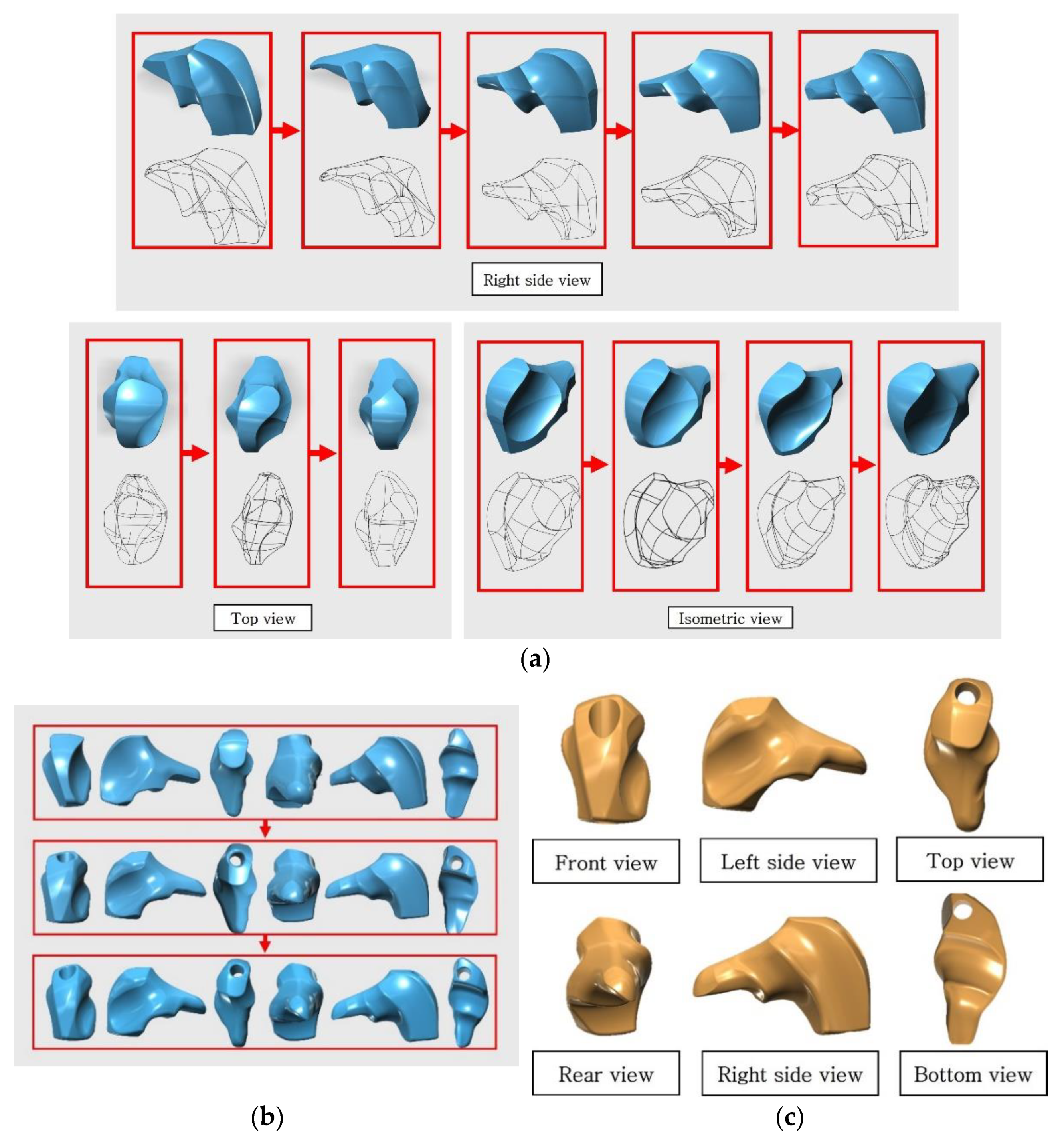
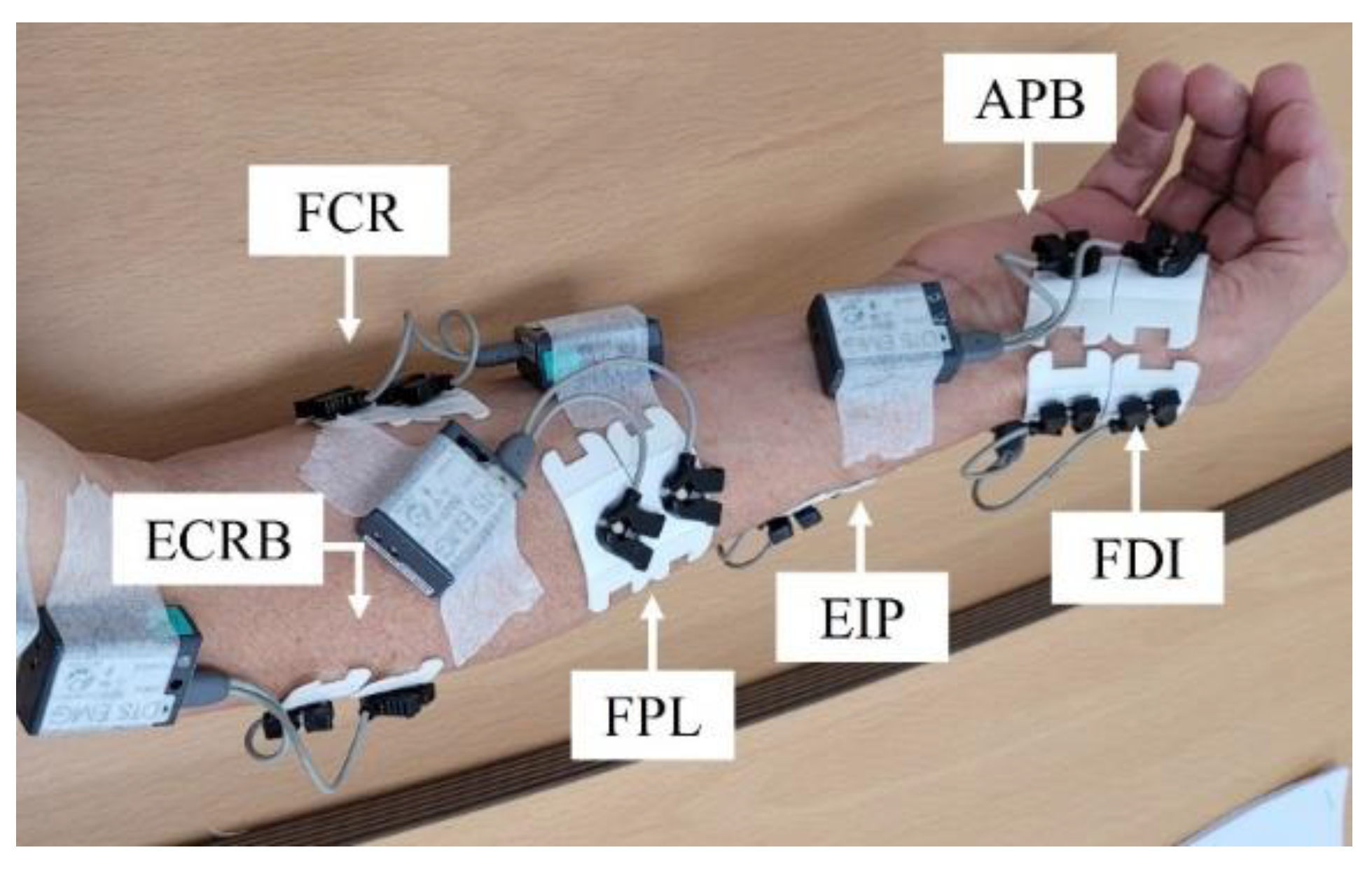


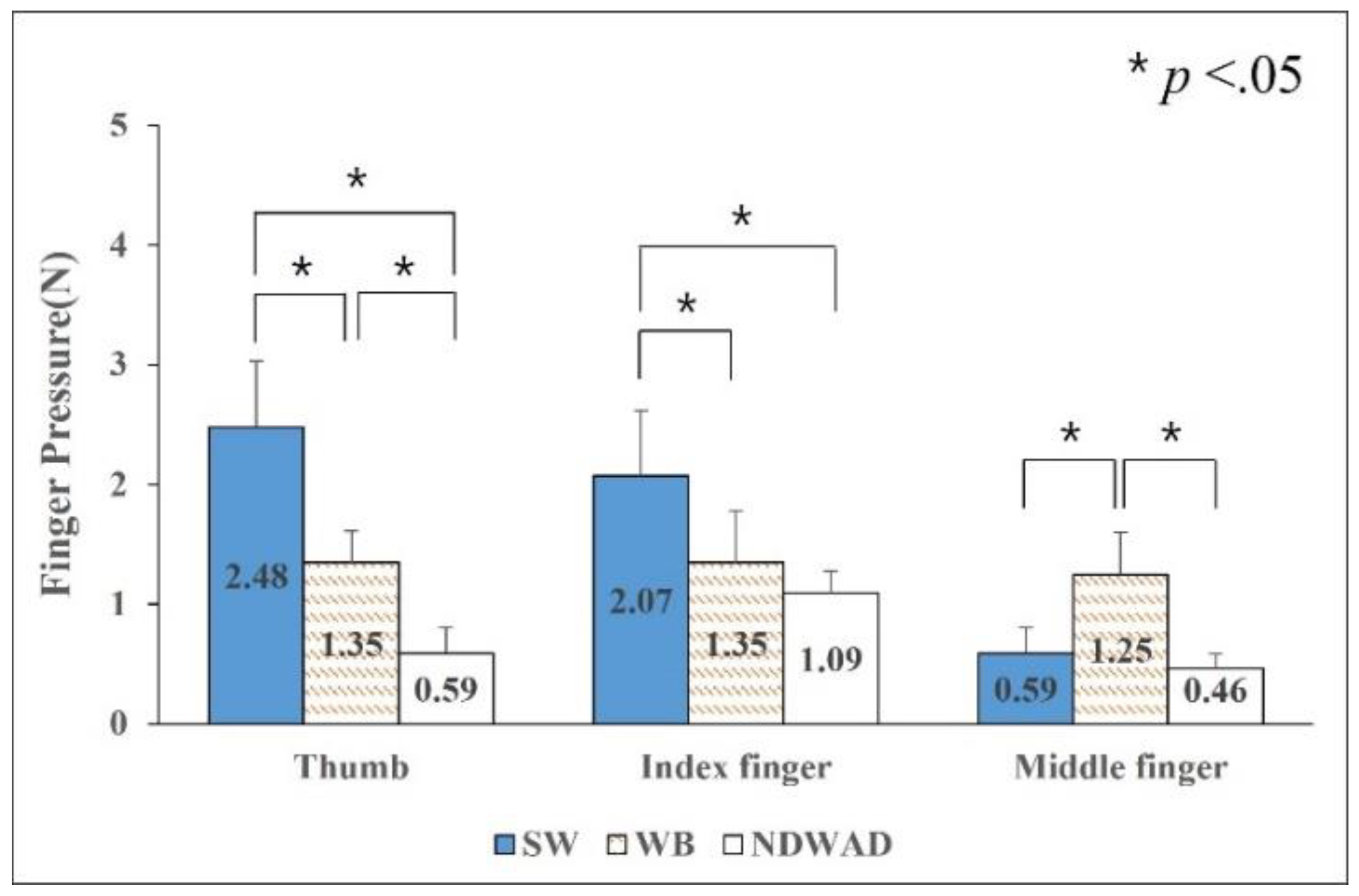
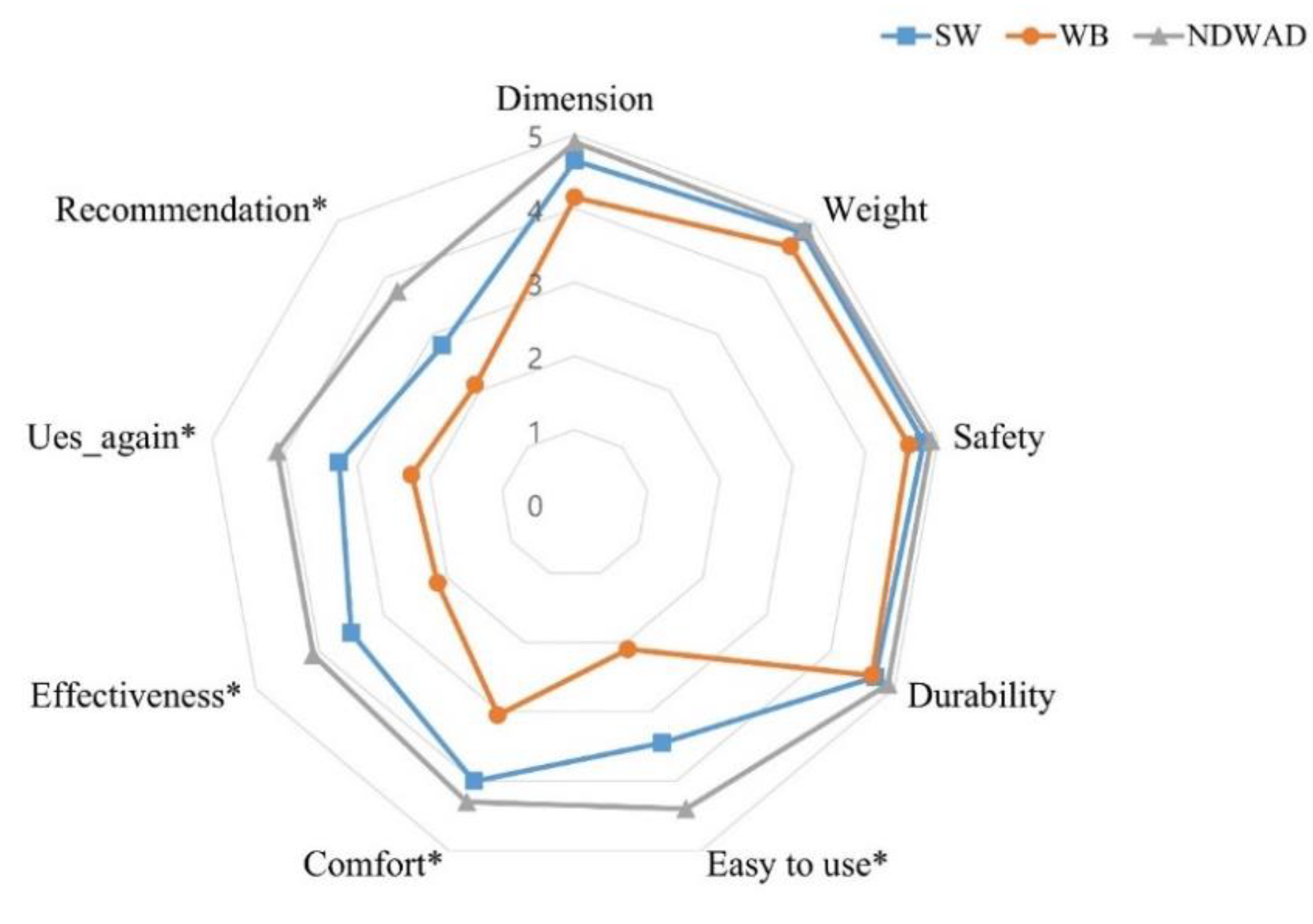
| N = 20 | Sex | Age |
|---|---|---|
| 6 | Male | 78.5 ± 0.9 |
| 14 | Female | 77.9 ± 3.2 |
| Gender | Hand Length | Middle Finger Length | Palm Width |
|---|---|---|---|
| Male | 18.82 ± 0.69 | 8.27 ± 0.56 | 8.90 ± 0.60 |
| Female | 17.29 ± 0.77 | 7.43 ± 0.37 | 8.13 ± 0.44 |
| Mean | 18.05 ± 0.73 | 7.85 ± 0.47 | 8.51 ± 0.52 |
| Name | SW | WB | NDWAD | |
|---|---|---|---|---|
| Figure | 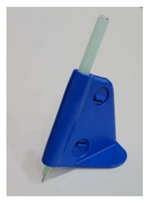 | 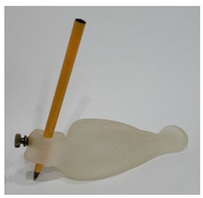 | 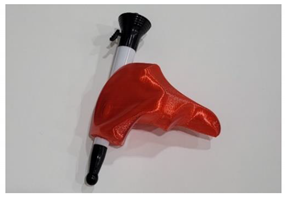 | |
| Weight (g) | 30.0 | 170.1 | 24.6 (S) | 29.0 (M) |
| Size (mm) | 63.5 × 50.8 × 11.43 | 146.1 × 63.5 × 38.1 | 90.5 × 43.5 × 62.3 | 97.5 × 48.2 × 67.6 |
| Feature | Similar to dynamic tripod grip, triangle bottom surface. | Similar to mouse grip, flat bottom surface. | Dynamic tripod grip improvement, ergonomic design. | |
| Model name | Steady Write | Writing Bird | - | |
| Manufacturer | Maddak, Inc., Wayne, NJ, USA | North Coast Medical, Inc., Morgan Hill, CA, USA | - | |
| Material | HIPS plastic (hard) | Acrylic (hard) | TPU (soft) | |
| No. | Satisfaction Assessment Item |
|---|---|
| 1 | Dimension |
| 2 | Weight |
| 3 | Safety |
| 4 | Durability |
| 5 | Easy to use |
| 6 | Comfort |
| 7 | Effectiveness |
| 8 | Use again |
| 9 | Recommendation |
| Muscle Activity (%) | SW | WB | NDWAD | F | p | Post-Hoc (Tukey) |
|---|---|---|---|---|---|---|
| APB | 19.05 | 10.25 | 18.16 | 6.14 | 0.004 * | b < a, c |
| FPL | 14.19 | 14.70 | 18.03 | 1.69 | 0.196 | |
| FDI | 16.38 | 8.73 | 14.17 | 11.46 | 0.000 * | b < a, c |
| EIP | 13.73 | 14.00 | 12.94 | 0.16 | 0.856 | |
| FCR | 8.65 | 10.20 | 8.97 | 0.61 | 0.546 | |
| ECRB | 29.79 | 29.13 | 30.52 | 0.11 | 0.899 |
| Finger Pressure (N) | SW | WB | NDWAD | F | p | Post-Hoc (Tukey or Mann Whitney U) |
|---|---|---|---|---|---|---|
| Thumb | 2.48 | 1.35 | 0.59 | 29.06 | 0.000 * | c < a, b, c < b < a |
| Index finger | 2.07 | 1.35 | 1.09 | 12.42 | 0.002 * | b, c < a |
| Middle finger | 0.59 | 1.25 | 0.46 | 13.30 | 0.000 * | b < a, c |
| Item | Cronbach’s Alpha |
|---|---|
| Dimension | 0.853 |
| Weight | 0.860 |
| Safety | 0.855 |
| Durability | 0.859 |
| Easy to use | 0.825 |
| Comfort | 0.832 |
| Effectiveness | 0.826 |
| Use again | 0.827 |
| Recommendation | 0.838 |
| Cronbach’s alpha | 0.858 |
| Items | SW Mean ± SD (Range) | WB Mean ± SD (Range) | NDWAD Mean ± SD (Range) | Chi-Square | p |
|---|---|---|---|---|---|
| Dimension | 4.65 ± 0.88 (2–5) | 4.15 ± 1.42 (1–5) | 4.90 ± 0.45 (3–5) | 4.83 | 0.089 |
| Weight | 4.80 ± 0.52 (3–5) | 4.55 ± 1.05 (1–5) | 4.85 ± 0.49 (3–5) | 0.92 | 0.631 |
| Safety | 4.80 ± 0.52 (3–5) | 4.60 ± 1.05 (1–5) | 4.90 ± 0.45 (3–5) | 1.25 | 0.534 |
| Durability | 4.70 ± 0.80 (2–5) | 4.65 ± 0.88 (2–5) | 4.90 ± 0.45 (3–5) | 1.30 | 0.522 |
| Easy to use | 3.45 ± 1.36 (1–5) | 2.10 ± 0.91 (1–4) | 4.40 ± 0.82 (3–5) | 26.89 | 0.000 * |
| Comfort | 4.00 ± 1.21 (2–5) | 3.05 ± 1.64 (1–5) | 4.30 ± 0.92 (3–5) | 7.23 | 0.027 * |
| Effectiveness | 3.50 ± 1.32 (1–5) | 2.15 ± 1.23 (1–5) | 4.10 ± 1.17 (1–5) | 18.88 | 0.000 * |
| Use again | 3.25 ± 1.33 (1–5) | 2.25 ± 1.25 (1–5) | 4.10 ± 1.25 (1–5) | 15.78 | 0.000 * |
| Recommendation | 2.80 ± 1.15 (1–5) | 2.10 ± 1.07 (1–5) | 3.75 ± 1.29 (1–5) | 15.072 | 0.001 * |
| Mean satisfaction | 3.99 ± 0.51 (1.78–5.00) | 3.29 ± 0.58 (1.11–4.89) | 4.47 ± 0.40 (2.33–5.00) |
| Item | N (%) | Ranking |
|---|---|---|
| Dimension | 4 (6.67) | 7 |
| Weight | 0 (0.00) | 8 |
| Safety | 5 (8.33) | 6 |
| Durability | 0 (0.00) | 8 |
| Easy to use | 10 (16.67) | 3 |
| Comfort | 16 (26.67) | 1 |
| Effectiveness | 13 (21.67) | 2 |
| Use again | 6 (10.00) | 4 |
| Recommendation | 6 (10.00) | 4 |
| Complaint | SW | WB | NDWAD |
|---|---|---|---|
| Dimension | 5% | 15% | - |
| Weight | - | 5% | - |
| Safety | - | 5% | - |
| Durability | 5% | 5% | - |
| Easy to use | 30% | 65% | - |
| Comfort | 15% | 40% | - |
| Effectiveness | 25% | 70% | 5% |
| Use again | 35% | 60% | 10% |
| Recommendation | 40% | 65% | 15% |
Publisher’s Note: MDPI stays neutral with regard to jurisdictional claims in published maps and institutional affiliations. |
© 2022 by the authors. Licensee MDPI, Basel, Switzerland. This article is an open access article distributed under the terms and conditions of the Creative Commons Attribution (CC BY) license (https://creativecommons.org/licenses/by/4.0/).
Share and Cite
Kim, S.; Jung, J.-Y.; Yang, C.-M.; Lee, Y.-K.; Kim, J.-J. Development of an Ergonomic Writing Assistive Device for Finger Pain Reduction in the Elderly. Appl. Sci. 2022, 12, 993. https://doi.org/10.3390/app12030993
Kim S, Jung J-Y, Yang C-M, Lee Y-K, Kim J-J. Development of an Ergonomic Writing Assistive Device for Finger Pain Reduction in the Elderly. Applied Sciences. 2022; 12(3):993. https://doi.org/10.3390/app12030993
Chicago/Turabian StyleKim, Sol, Ji-Yong Jung, Chang-Min Yang, Yeon-Kyun Lee, and Jung-Ja Kim. 2022. "Development of an Ergonomic Writing Assistive Device for Finger Pain Reduction in the Elderly" Applied Sciences 12, no. 3: 993. https://doi.org/10.3390/app12030993
APA StyleKim, S., Jung, J.-Y., Yang, C.-M., Lee, Y.-K., & Kim, J.-J. (2022). Development of an Ergonomic Writing Assistive Device for Finger Pain Reduction in the Elderly. Applied Sciences, 12(3), 993. https://doi.org/10.3390/app12030993






